Have you ever felt like your team works harder every day but still falls further behind?
It feels like trying to fill a leaky bucket. No matter how much effort you pour in, the results never seem to add up.
Without a strong productivity improvement plan, even the best teams can slowly lose direction. Important tasks slip through the cracks while workflows become scattered. Deadlines that once felt achievable suddenly seem out of reach.
As time passes, long-term goals drift further away.
Work hours disappear into endless decision-making, missed check-ins, and constant notifications that pull focus from real priorities.
Small inefficiencies quietly grow into bigger problems when daily tasks lack structure and time management weakens.
Eventually, employee engagement drops and teamwork weakens.
The entire work environment starts to feel heavier, even when everyone is giving their best effort.
How can a team stay on track toward meaningful milestones if the foundation is missing?
How much time, energy, and profitability are lost simply because there is no productivity improvement plan in place?
These challenges do not happen overnight.
Instead, they build slowly, day after day, until productivity levels fall, workflows collapse, and momentum becomes harder to regain.
In this article, you will learn how to recognize the signs and take action with 9 simple steps to create a productivity improvement plan that builds stronger teams, better focus, and real results.

Table of Contents
- What is a productivity improvement plan?
- Why is a productivity improvement plan important for your team?
- 9 steps to a productivity improvement plan for time management
- 5 best practices to maintain high productivity levels
- 4 common mistakes to avoid in your productivity improvement plan
- How do you measure success in your productivity improvement plan?
- Helpful tools to support your productivity improvement plan
- How Time Doctor helps improve time management and team productivity
What is a productivity improvement plan?
An effective productivity plan is a structured roadmap that helps teams prioritize important tasks, improve strategic planning, and achieve long-term goals.
It clearly outlines for every team member how to manage daily tasks, reduce bottlenecks, and stay focused on what matters most.
Instead of leaving success to chance, a productivity improvement plan creates intentional workflows, measurable milestones, and better decision-making at every level.
As Stephen Covey, author of The 7 Habits of Highly Effective People, said, “The key is not to prioritize what is on your schedule, but to schedule your priorities.”
A true productivity improvement plan helps teams work faster and focus on the most important tasks within a set time frame.
It is the foundation for stronger teamwork, sharper focus, and better business results.
Why is a productivity improvement plan important for your team?
Building a productivity improvement plan is more than organizing tasks. It creates a clear path that helps teams stay focused, engaged, and ready to achieve their goals. Here’s why it matters:
1. Master time management and focus on important tasks
A structured plan ensures that every work hour is used wisely. It helps team members spend their energy on daily tasks that align with long-term goals instead of getting lost in low-priority work.
2. Reduce burnout and stress across the team
Without clear workflows and time-bound goals, teams often feel overwhelmed. A productivity improvement plan sets clear expectations, protects well-being, and keeps workloads manageable, especially during busy periods.
3. Boost employee productivity and improve overall profitability
When teams prioritize the most important tasks, eliminate bottlenecks, and automate similar tasks, they can accomplish more in less time. This leads to stronger results and a positive impact on the organization’s bottom line.
4. Create smarter workflows and support faster decision-making
A good plan connects daily activities to milestones through organized workflows and templates. This structure improves decisions and helps teams avoid wasting time on repetitive or unclear tasks.
5. Support a healthy work environment for remote, hybrid, and in-office teams
Whether your team works remotely, in a hybrid setup, or in-office, a clear productivity improvement plan builds consistency. It creates a sense of accomplishment, strengthens teamwork, and improves employee engagement across every workspace.
9 steps to a productivity improvement plan for time management
Creating an effective productivity improvement plan starts with clear, simple steps. Here’s how each one fits together:
Step 1: Analyze your current workflows
Start by reviewing how your daily operations flow from task to task. This step helps you understand where work hours are going and where delays often occur. A clear view of your workflows is essential for identifying areas that need improvement.
Step 2: Identify bottlenecks and inefficiencies
Once you analyze the flow, focus on spotting bottlenecks such as slow approvals, repeated mistakes, and disconnected communication. Recognizing inefficiencies early helps prevent wasted time and keeps daily tasks moving forward.
Step 3: Set achievable, clear, and time-bound goals
Establish goals that are realistic, measurable, and fit within a defined time frame. Applying the Pareto principle, you can prioritize the tasks that impact long-term goals most while keeping workloads manageable for your team members.
Step 4: Prioritize the most important daily tasks
Separate urgent tasks from important ones by using the Eisenhower matrix, a simple time management tool that organizes tasks into four clear categories:
- Urgent and important: Do these tasks immediately.
- Important but not urgent: Schedule these tasks for later.
- Urgent but not important: Delegate these tasks if possible.
- Not urgent and not important: Eliminate these tasks to save time.
This structure helps teams focus their energy on meaningful daily tasks instead of getting caught in constant firefighting.
It improves productivity levels, strengthens decision-making, and makes time management much easier across every workday.
Step 5: Design better workflows and templates
Organize workflows around similar tasks and create reusable templates that simplify the workday. Well-structured workflows help teams save time, reduce confusion, and maintain momentum across multiple projects.
Step 6: Choose project management and employee time tracking tools
Select project management software that supports your team’s style of work. Introduce employee time tracking tools to monitor how much time is spent on tasks, automate repetitive actions, and improve strategic planning across workflows.
Step 7: Track productivity levels and real-time progress
Monitor team performance through workforce analytics and real-time notifications. Tracking productivity levels consistently gives you valuable employee insight into how well daily tasks align with milestones and overall goals.
Step 8: Conduct regular check-ins and follow-ups
Schedule frequent check-ins to track milestone progress, review team well-being, and strengthen teamwork. Consistent follow-ups keep the productivity improvement plan alive instead of letting goals drift over time.
Step 9: Review results and refine your productivity plan
Finally, success can be measured by reviewing key metrics such as time saved, tasks completed, and boost in employee productivity. Adjust your plan as needed to reflect new challenges, team feedback, and changes in your strategic planning.
5 best practices to maintain high productivity levels
Keeping productivity levels high requires more than working harder. It depends on building small habits that support focus, teamwork, and smarter workflows every day.
Here are 5 best practices that make a lasting difference:
1. Use the Pomodoro technique to manage focus and breaks
The Pomodoro technique is a time management method that helps boost focus by working in short, controlled bursts.
The basic formula is simple:
You work for 25 minutes on a single task, then take a 5-minute break to recharge.
After completing four cycles, you take a longer break of about 15 to 30 minutes.
This method improves productivity by encouraging deep focus while giving the brain regular chances to reset.
It makes daily tasks more manageable, protects concentration during the workday, and helps prevent burnout from long, uninterrupted work hours.
2. Encourage strong teamwork and fix bottlenecks quickly
Productivity improves when teams communicate openly and work together to solve minor problems before they grow.
Addressing bottlenecks early keeps workflows moving smoothly and helps team members stay motivated and connected to their goals.
3. Organize your workspace to eliminate distractions
A clean, organized workspace supports better focus and faster decision-making. Whether your team is remote, hybrid, or in-office, creating a workspace that minimizes distractions helps everyone manage their time and daily tasks more effectively.
4. Celebrate short-term wins to create a strong sense of accomplishment
Recognizing small achievements builds momentum and reinforces positive work habits. Celebrating milestones, no matter how small, encourages employee engagement and helps teams stay motivated through both short-term projects and long-term goals.
5. Manage notifications wisely to minimize interruptions
Constant notifications can pull attention away from important tasks and slow down workflows. Setting boundaries around communication tools protects focus, saves valuable work hours, and keeps teams aligned on their most important priorities.
4 common mistakes to avoid in your productivity improvement plan
Even the best productivity improvement plans can fall short if a few key areas are overlooked.
Here are 4 common mistakes to watch for and why it is important to avoid them:
1. Setting unclear or unrealistic goals
Teams lose focus and direction when goals are vague or out of reach. Setting clear goals that are achievable within a set time frame gives team members a real target to aim for and helps maintain steady progress toward important milestones.
2. Ignoring work environment challenges
A cluttered or stressful work environment can quickly lower productivity levels. Whether your team is remote, hybrid, or in-office, creating a space that supports focus, well-being, and daily task management is essential for sustained success.
3. Giving team members too much work without understanding the time needed
Assigning too many responsibilities without understanding the time required often leads to burnout and missed deadlines. Tracking work hours, using workforce analytics, and planning achievable workloads protect productivity and employee engagement.
4. Skipping regular follow-ups and feedback sessions
Without frequent check-ins, minor problems can quietly grow into bigger challenges. Scheduling regular follow-ups helps monitor milestones, adjust workflows when needed, and keep teamwork strong across every phase of your productivity improvement plan.
How do you measure success in your productivity improvement plan?
A strong productivity improvement plan needs more than good intentions. In fact, it needs clear ways to measure real progress.
Tracking the right productivity analytics shows whether your strategies are working or where adjustments are needed.
Here are 4 simple ways to measure success, along with examples:
1. Track the amount of time saved
Compare how much time tasks used to take versus how long they take now.
For example, if a project that once needed 10 work hours is now completed in 7, your new workflows and templates are making a real impact.
2. Measure the number of most important tasks completed
Look at how many critical tasks your team finishes within a set time frame. If teams complete more high-priority daily tasks without sacrificing quality, your time management and strategic planning are moving in the right direction.
3. Monitor boosts in employee productivity
Use workforce analytics to track productivity levels across different teams or projects. For instance, if employee productivity rises after introducing a new project management software, it signals that your tools and workflows are helping teams work smarter.
4. Watch for a reduction of bottlenecks and project delays
Identify whether previous slowdowns, such as approval bottlenecks or missed milestones, are happening less often.
If your team can move through daily tasks faster and hit important deadlines more consistently, your productivity improvement efforts are paying off.
As Brian Tracy, time management expert and author of Eat That Frog!: 21 Great Ways to Stop Procrastinating and Get More Done in Less Time, said, “Every minute you spend in planning saves ten minutes in execution.”
In Eat That Frog!, Tracy explains how focusing on your most important tasks first, instead of procrastinating, leads to faster results, better focus, and greater overall productivity.
By measuring results regularly, you can refine your productivity improvement plan and ensure that your team’s time and energy always drive the right outcomes.
Helpful tools to support your productivity improvement plan
The right tools make employee tracking time, managing daily tasks, and building stronger workflows much easier.
Here are some helpful tools that can support your productivity improvement plan and help your team work more innovative every day:
1. Time Doctor
Time Doctor is a powerful tool for employee time tracking, monitoring, workforce management, and productivity analytics. It allows team members to track their time spend on tasks, monitor real-time workflows, and manage work hours more accurately.
By using Time Doctor, you can boost productivity levels, spot inefficiencies early, and create a healthier work environment without micromanagement.
2. Asana, Monday, Trello, and ClickUp
They are popular project management software options that help teams organize projects, track milestones, and manage daily workflows. These tools allow you to assign tasks, monitor progress in real time, and simplify decision-making by giving everyone full visibility into project timelines and responsibilities.
3. Todoist
Todoist is a practical tool for managing daily to-do lists and tracking short-term goals. It helps individuals and teams stay focused by organizing daily tasks simply and visually.
By using Todoist, you can prioritize important tasks, monitor work hours, and build a stronger sense of accomplishment throughout the workday.
4. Zapier
Zapier is an automation platform that connects different apps and automates repetitive tasks. It saves valuable work hours by eliminating manual actions such as updating spreadsheets, sending follow-up emails, or moving project updates across platforms.
Using Zapier allows teams to streamline workflows, automate similar tasks, and focus their energy on higher-value projects.
How Time Doctor helps improve time management and team productivity
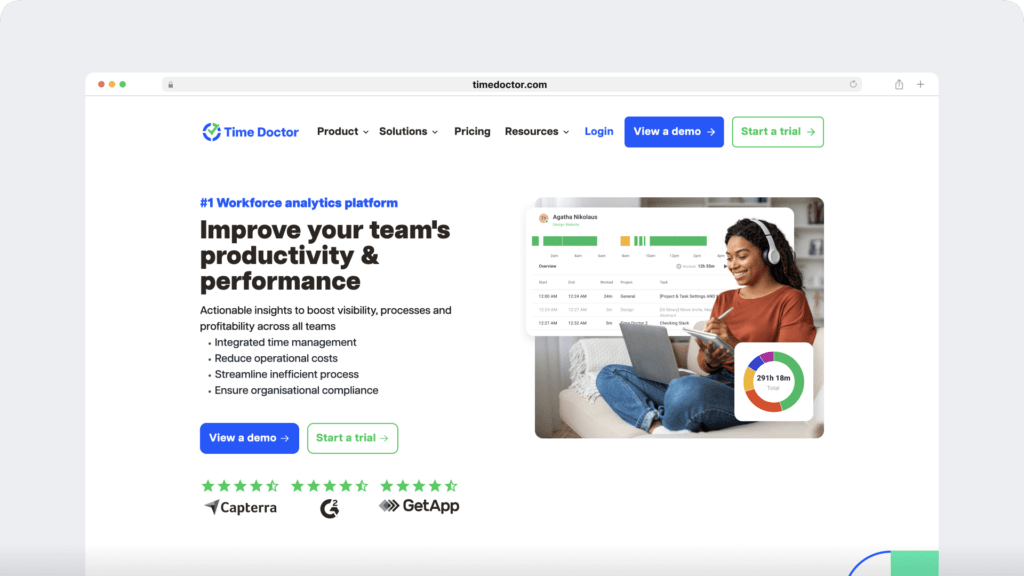
Choosing the right tool can make all the difference when building a strong productivity improvement plan.
Time Doctor offers a complete way to manage work hours, improve workflows, and support every team member’s productivity without adding extra pressure.
Take a look at how Time Doctor strengthens teamwork and makes time management easier.
1. Track real-time work hours accurately
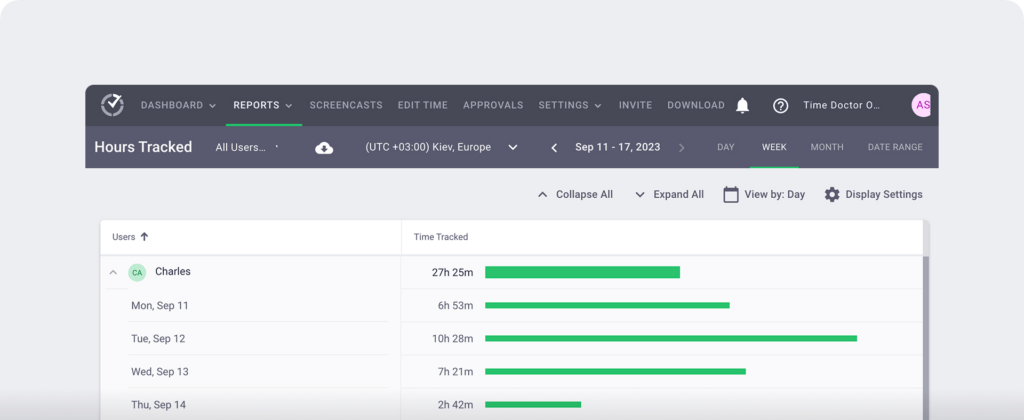
Time Doctor gives you clear visibility into how much time is spent on daily tasks, helping teams stay focused and projects stay on track.
2. Manage attendance and payroll efficiently

With built-in attendance tracking and easy payroll integrations, Time Doctor simplifies administrative work and saves valuable time across the team.
3. Monitor screens without micromanagement
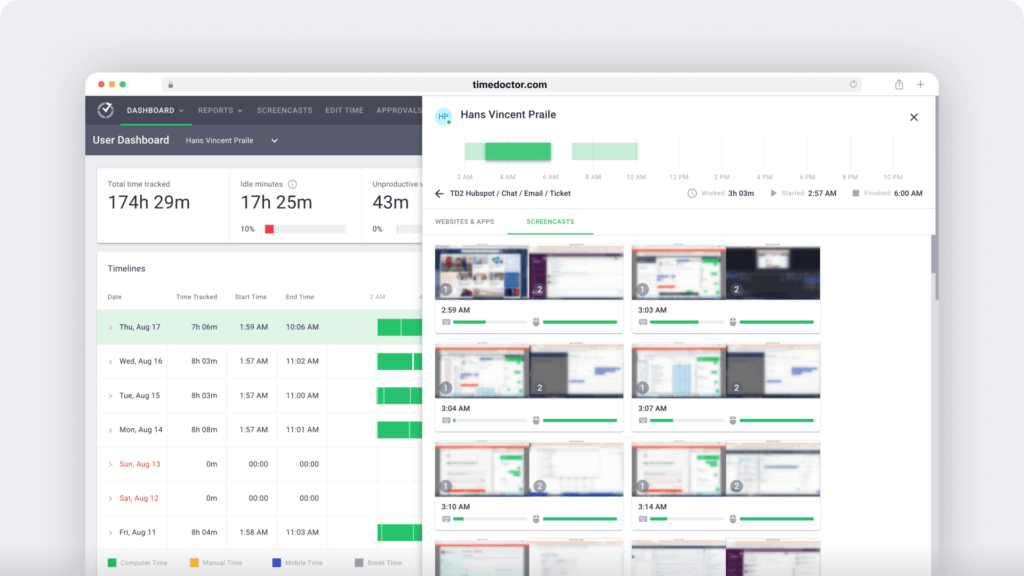
Screen monitoring happens transparently, building accountability and trust while protecting employee engagement and well-being.
4. Integrates easily with your favorite project management software
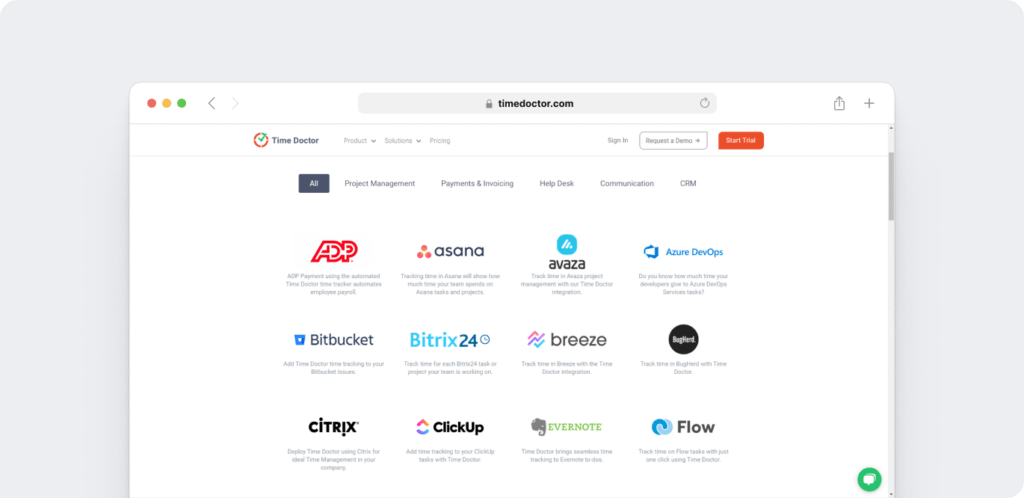
Whether your team uses Monday, Asana, Trello, ClickUp, or other tools, Time Doctor integrates seamlessly to your existing workflows to make project tracking smoother.
5. Use workforce analytics to spot trends and improve decision-making
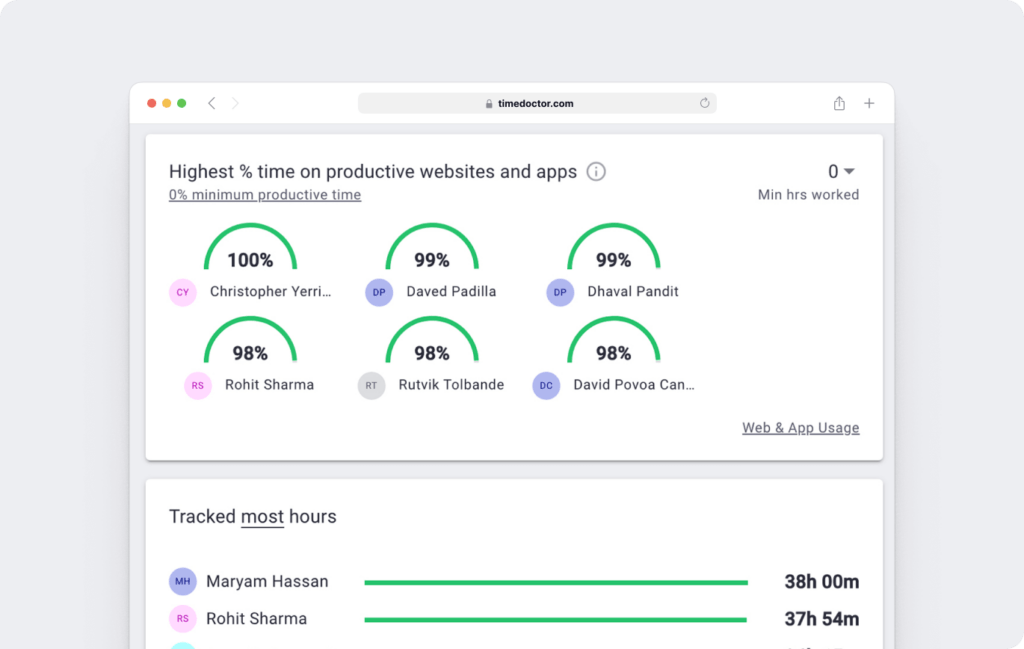
Real-time productivity analytics help identify bottlenecks, improve daily task management, and boost overall productivity levels over time.
Time Doctor builds stronger teams and creates work environments where everyone can thrive more easily.
Final thoughts
Imagine how much stronger your team could become with clear goals, organized workflows, and better time management.
What new opportunities could you unlock if every daily task moved your team closer to long-term success?
How much time and energy could you save by building a work environment that supports real focus and teamwork?
With a strong productivity improvement plan, your team can stay ahead of deadlines, protect work hours, and feel a greater sense of accomplishment every day.
Building strong habits around time management, teamwork, and strategic planning opens the door to greater success.
Time Doctor gives you the tools to lead smarter, strengthen teamwork, and build a work environment where every workday moves you closer to what matters most.
Lead smarter, boost productivity, and build stronger workflows with Time Doctor.
Get a free demo and start creating your productivity improvement plan today.

Liam Martin is a serial entrepreneur, co-founder of Time Doctor, Staff.com, and the Running Remote Conference, and author of the Wall Street Journal bestseller, “Running Remote.” He advocates for remote work and helps businesses optimize their remote teams.


